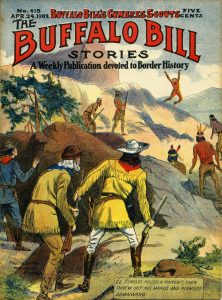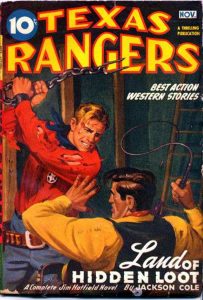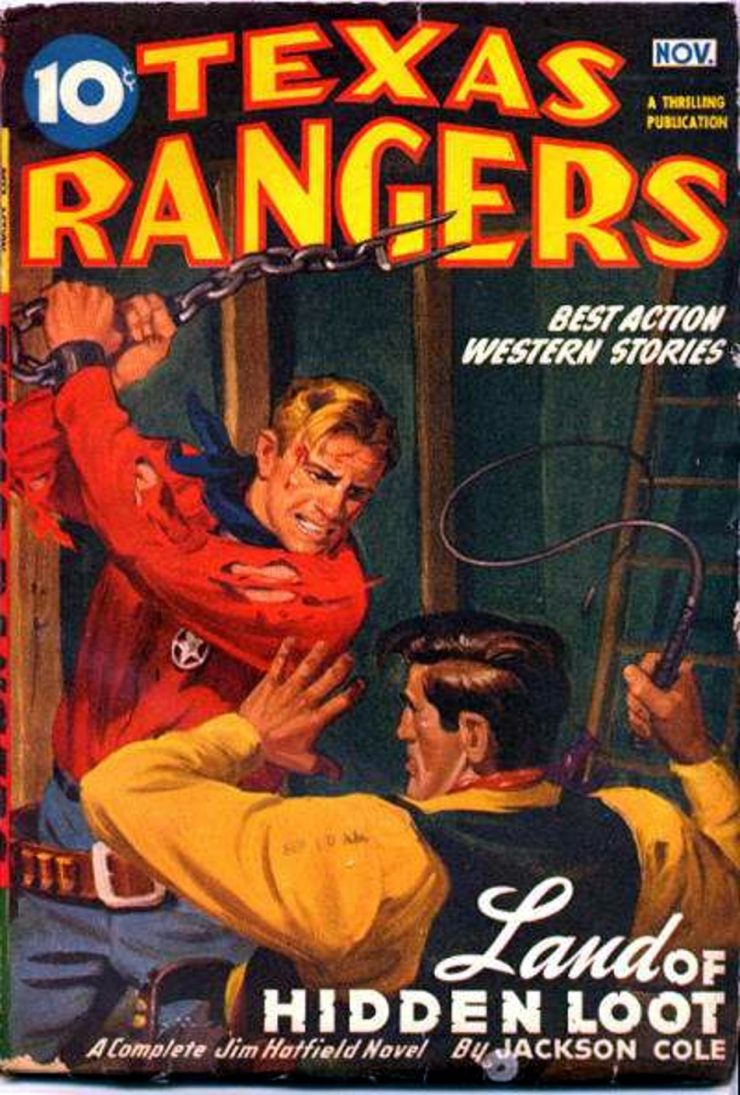 The western story got its start with James Fenimore Cooper’s Leatherstocking Tales, a fictional adaptation of the adventures of frontiersman Daniel Boone. In the years following Cooper’s Natty Bumppo series, authors such as Bret Harte, Francis Parkman, and Mark Twain further expanded the field.
The western story got its start with James Fenimore Cooper’s Leatherstocking Tales, a fictional adaptation of the adventures of frontiersman Daniel Boone. In the years following Cooper’s Natty Bumppo series, authors such as Bret Harte, Francis Parkman, and Mark Twain further expanded the field.
According to an essay written by pulp scribe John A. Saxon and published in 1945 by WRITER’S DIGEST, the western story became a genre of its own during the second half of the 19th century. In 1869, writer Edward Zane Carroll Judson convinced hunter, scout, and showman William F. Cody to lend his name and reputation to a fictionalized account of his life, “Buffalo Bill, King of the Borderman,” originally serialized in Street & Smith’s NEW YORK WEEKLY. Phenomenally received, Judson found a public hungry for further adventures of the real life hero of the American frontier. Thus started “. . . the fictionalized form of the Western story . . . based partly on fact, but mostly on imagination.”
Given the great success of Street & Smith’s Buffalo Bill tales, nickel weeklies and dime novels devoted to western heroes and outlaws soon followed: DEADWOOD DICK LIBRARY, DIAMOND DICK LIBRARY, JAMES BOYS WEEKLY, KLONDIKE KIT LIBRARY, WILD WEST WEEKLY, and more. These as well as stories featuring detective heroes such as Nick Carter and Old Sleuth and sports heroes such as Frank Merriwell, reigned supreme for nearly forty years. Then, following the introduction of the pulp magazine by Frank A. Munsey in 1896, the story papers and dime novels began to give way to these more economical rough-paper periodicals.
The first all-western pulp magazine was introduced by Street & Smith when they converted their tired old story paper, NEW BUFFALO BILL WEEKLY, to WESTERN STORY MAGAZINE in 1919. Within a year, the magazine reached a circulation of 300,000 copies per issue and began to be released weekly, a status it enjoyed for the next twenty-five years. Soon thereafter, the magazine began publishing the western fantasies of poet turned pulp writer Frederick Schiller Faust–better known as Max Brand–and really took off. By the late 1920s, WESTERN STORY was competing against countless imitators–ACE-HIGH, COWBOY STORIES, FRONTIER, GOLDEN WEST, LARIAT, NORTH-WEST STORIES, RANCH ROMANCES, WEST, and others.
With the collapse of the world economy in 1929 and spare change hard to come by, ten-cent western pulps began to flood the market. Introduced by Popular Publications in late 1931 when they debuted DIME WESTERN MAGAZINE, other companies followed suit with their own ten-cent western fiction magazines. One of these firms was Ned Pines’ Standard Magazines, with managing editor Leo Margulies riding herd over the new publisher’s Thrilling Group.
Although Margulies seemed to be forever complaining that western writers were “deceiving themselves in the belief that all a Western story needed was plenty of gun slinging; plenty of people killed; plenty of fights, but never mind a good reason,” his line of western pulps featured “. . . thrilling tales of the gallant West where danger lurks and cowboys are supermen.” According to pulp scholar John Dinan, Standard’s typical western superhero “could absorb more than his share of punishment” and was “characterized by immediate action in response to a dilemma or conflict which was always external.”
 On Thursday, August 13th, Ed Hulse will explore the Standard line of western superhero pulps, from TEXAS RANGERS, launched in 1936 and featuring the “Lone Wolf” Ranger, Jim Hatfield; to MASKED RIDER WESTERN MAGAZINE, purchased from Ranger Publications in 1938 and starring Wayne Morgan, “the Robin Hood of the West;” to RANGE RIDERS and its “stories of western avengers in action;” to THE RIO KID WESTERN, a pulp that featured “the fictional exploits of the Kid . . . interwoven with actual historical characters;” to WEST and its lengthy series featuring Johnston McCulley’s Zorro; and HOPALONG CASSIDY’S WESTERN MAGAZINE, featuring Louis L’Amour’s blend of Clarence E. Mulford’s original character with the movie version popularized by actor William Boyd. Ed will also be touching on such characters as Alamo Paige, Navajo Raine, and W. C. Tuttle’s Tombstone and Speedy, all featured in EXCITING WESTERN, and A. Leslie Scott’s Texas Ranger Walt Slade, whose adventures ran in Standard’s flagship western title, THRILLING WESTERN.
On Thursday, August 13th, Ed Hulse will explore the Standard line of western superhero pulps, from TEXAS RANGERS, launched in 1936 and featuring the “Lone Wolf” Ranger, Jim Hatfield; to MASKED RIDER WESTERN MAGAZINE, purchased from Ranger Publications in 1938 and starring Wayne Morgan, “the Robin Hood of the West;” to RANGE RIDERS and its “stories of western avengers in action;” to THE RIO KID WESTERN, a pulp that featured “the fictional exploits of the Kid . . . interwoven with actual historical characters;” to WEST and its lengthy series featuring Johnston McCulley’s Zorro; and HOPALONG CASSIDY’S WESTERN MAGAZINE, featuring Louis L’Amour’s blend of Clarence E. Mulford’s original character with the movie version popularized by actor William Boyd. Ed will also be touching on such characters as Alamo Paige, Navajo Raine, and W. C. Tuttle’s Tombstone and Speedy, all featured in EXCITING WESTERN, and A. Leslie Scott’s Texas Ranger Walt Slade, whose adventures ran in Standard’s flagship western title, THRILLING WESTERN.
For decades now, Ed Hulse has been scouring the back alleys and deserted farmhouses of his home state of New Jersey, searching for old pulps and 16mm prints of vintage motion pictures. Not content with what he was finding in Jersey, he can now be found rummaging through boxes of old pulp magazines in places as far away as Singapore and Kodiak, Alaska, trying to find a pulp that measures up to his lofty standards. When not sifting through eBay listings, Ed works as a free-lance journalist. One of the founders of PulpFest, Ed has been helping to organize pulp and film conventions for many years. He’s the guy who runs the movie projector at the Windy City Pulp and Paper Convention and also publishes BLOOD ‘N’ THUNDER, the leading pulp and popular culture fanzine of our day and age, and Murania Press books such as J. Allan Dunn’s THE ISLAND and his own HANDSOME HEROES AND VICIOUS VILLAINS. Additionally, Ed has written extensively about both the pulp and motion-picture fields. His THE BLOOD ‘N’ THUNDER GUIDE TO PULP FICTION should be on the bookshelves of every pulp collector. Ed’s publications are available through Amazon.com and other fine booksellers. In 2007, Ed was presented with the Lamont Award for his exceptional work within the pulp community.
“Saddle Up! Thrilling’s Western Heroes” will begin at 9:20 PM on Thursday, August 13th, on the second floor of the Hyatt-Regency hotel in beautiful downtown Columbus, Ohio. It’s all part of this year’s “Salute to Standard Magazines,” taking place at PulpFest 2015. Learn how you can register for “Summer’s Great Pulp Con” by clicking here.
(THE BUFFALO BILL STORIES was the first publication devoted to fiction about frontiersman William F. Cody. A weekly publication “devoted to border history,” it debuted with its May 18, 1901 number and was published by Street & Smith. Pictured here is the April 24, 1909 issue. To learn more about the evolution of the pulp western, read John Dinan’s THE PULP WESTERN, Ron Goulart’s CHEAP THRILLS, and Will Murray’s WORDSLINGERS. According to dime novel scholar J. Randolph Cox, most of the covers for Street & Smith periodicals published during the early 1900s were drawn by Charles L. Wrenn, Marmaduke Russell, Ed. Johnson, and J. A. Cahill.
TEXAS RANGERS was by far the most successful western pulp magazine devoted to a single character. Launched in 1936 to commemorate the centennial of the historical Texas Rangers, the magazine lasted for over twenty years, running for 206 issues (more than any other single-character pulp except for THE SHADOW). A. Leslie Scott or Tom Curry wrote many of the lead novels, using the house name of Jackson Cole. There’s an excellent chapter on Standard’s western superheroes in Don Hutchison’s history of the single-character magazines, THE GREAT PULP HEROES. Pictured here is the November 1946 issue of TEXAS RANGERS, featuring front cover art by Sam Cherry.)






